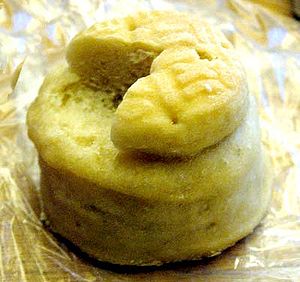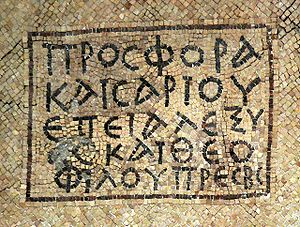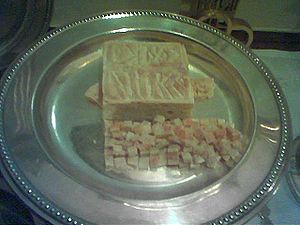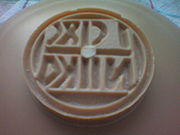
Prosphora
Encyclopedia

Bread
Bread is a staple food prepared by cooking a dough of flour and water and often additional ingredients. Doughs are usually baked, but in some cuisines breads are steamed , fried , or baked on an unoiled frying pan . It may be leavened or unleavened...
used in Orthodox Christian
Eastern Orthodox Church
The Orthodox Church, officially called the Orthodox Catholic Church and commonly referred to as the Eastern Orthodox Church, is the second largest Christian denomination in the world, with an estimated 300 million adherents mainly in the countries of Belarus, Bulgaria, Cyprus, Georgia, Greece,...
and Greek Catholic (Byzantine) liturgies. The plural form is prosphora (πρόσφορα). The term originally meant any offering
Offering
Offering may refer to:* Offering, a collection of donations during religious worship, see alms, tithe or charity* Offering, a religious sacrifice of plant, animal or human life* Offering , a part of devotional practice*Phan...
made to a temple
Temple
A temple is a structure reserved for religious or spiritual activities, such as prayer and sacrifice, or analogous rites. A templum constituted a sacred precinct as defined by a priest, or augur. It has the same root as the word "template," a plan in preparation of the building that was marked out...
, but in Orthodox Christianity it has come to mean specifically the bread offered at the Divine Liturgy
Divine Liturgy
Divine Liturgy is the common term for the Eucharistic service of the Byzantine tradition of Christian liturgy. As such, it is used in the Eastern Orthodox and Eastern Catholic Churches. Armenian Christians, both of the Armenian Apostolic Church and of the Armenian Catholic Church, use the same term...
(Eucharist).
Baking

- the finest pure wheat flourWheat flourWheat flour is a powder made from the grinding of wheat used for human consumption. More wheat flour is produced than any other flour. Wheat varieties are called "clean," "white," or "brown" if they have high gluten content, and they are called "soft" or "weak" flour if gluten content is low...
(white) - yeastYeastYeasts are eukaryotic micro-organisms classified in the kingdom Fungi, with 1,500 species currently described estimated to be only 1% of all fungal species. Most reproduce asexually by mitosis, and many do so by an asymmetric division process called budding...
- saltSaltIn chemistry, salts are ionic compounds that result from the neutralization reaction of an acid and a base. They are composed of cations and anions so that the product is electrically neutral...
- waterWaterWater is a chemical substance with the chemical formula H2O. A water molecule contains one oxygen and two hydrogen atoms connected by covalent bonds. Water is a liquid at ambient conditions, but it often co-exists on Earth with its solid state, ice, and gaseous state . Water also exists in a...
Any member of the church who is in good standing and whose conscience is clean may bake prosphora. Often in a parish church
Parish church
A parish church , in Christianity, is the church which acts as the religious centre of a parish, the basic administrative unit of episcopal churches....
the women will take turns baking the prosphora; in monasteries
Monastery
Monastery denotes the building, or complex of buildings, that houses a room reserved for prayer as well as the domestic quarters and workplace of monastics, whether monks or nuns, and whether living in community or alone .Monasteries may vary greatly in size – a small dwelling accommodating only...
, the task is often assigned by the Hegumen
Hegumen
Hegumen, hegumenos, igumen, or ihumen is the title for the head of a monastery of the Eastern Orthodox Church or Eastern Catholic Churches, similar to the one of abbot. The head of a convent of nuns is called hegumenia or ihumenia . The term means "the one who is in charge", "the leader" in...
(abbot or abbess) to one or several monastics of virtuous life.
It is common but not necessary to go to confession
Confession
This article is for the religious practice of confessing one's sins.Confession is the acknowledgment of sin or wrongs...
before baking prosphora, and it is often done in the morning while fasting
Fasting
Fasting is primarily the act of willingly abstaining from some or all food, drink, or both, for a period of time. An absolute fast is normally defined as abstinence from all food and liquid for a defined period, usually a single day , or several days. Other fasts may be only partially restrictive,...
. Sometimes, special kitchen implements are used for making the prosphora which are used for no other purpose. There may be special prayers said before commencing, and baker tries to maintain a religious state of mind throughout, often saying the Jesus Prayer
Jesus Prayer
The Jesus Prayer or "The Prayer" is a short, formulaic prayer esteemed and advocated within the Eastern Orthodox church:The prayer has been widely taught and discussed throughout the history of the Eastern Churches. It is often repeated continually as a part of personal ascetic practice, its use...
. Usually enough prosphora for a number of services are baked at the same time.
A prosphoron is made up of two separate round pieces of leavened dough which are placed one on top of another and baked together to form a single loaf. This double-loaf represents the two natures of Christ
Christology
Christology is the field of study within Christian theology which is primarily concerned with the nature and person of Jesus Christ as recorded in the Canonical gospels and the letters of the New Testament. Primary considerations include the relationship of Jesus' nature and person with the nature...
: human and divine. Before baking, each prosphoron is stamped with a seal usually bearing the image of a cross
Cross
A cross is a geometrical figure consisting of two lines or bars perpendicular to each other, dividing one or two of the lines in half. The lines usually run vertically and horizontally; if they run obliquely, the design is technically termed a saltire, although the arms of a saltire need not meet...
with the Greek letters IC XC NIKA ("Jesus Christ conquers") around the arms of the cross. This impression is baked into the bread and serves as a guide for the priest who will be cutting it.
In the Slavic practice (Russian Orthodox, Bulgarian Orthodox, Serbian Orthodox, etc.) five smaller prosphora are used (in commemoration of the five loaves Jesus
Jesus
Jesus of Nazareth , commonly referred to as Jesus Christ or simply as Jesus or Christ, is the central figure of Christianity...
used to feed the multitudes
Feeding the multitude
Feeding the multitude is the combined term used to refer to two separate miracles of Jesus in the Gospels.The First Miracle, "The Feeding of the 5,000" is the only miracle which is present in all four canonical Gospels...
). In the Greek practice one larger prosphoron is used (in commemoration that all share in one "Bread" ).
Divine liturgy



Divine Liturgy
Divine Liturgy is the common term for the Eucharistic service of the Byzantine tradition of Christian liturgy. As such, it is used in the Eastern Orthodox and Eastern Catholic Churches. Armenian Christians, both of the Armenian Apostolic Church and of the Armenian Catholic Church, use the same term...
(Eucharist
Eucharist
The Eucharist , also called Holy Communion, the Sacrament of the Altar, the Blessed Sacrament, the Lord's Supper, and other names, is a Christian sacrament or ordinance...
) known as the Liturgy of Preparation
Liturgy of Preparation
The Liturgy of Preparation, also Prothesis or Proskomedia , is the name given in the Eastern Orthodox Church and the Byzantine-rite Eastern Catholic Churches to the act of preparing the bread and wine for the Eucharist...
(Proskomedia) a cube is cut from the center of the prosphoron, and is referred to as the Lamb (Greek: Amnon). It is this Lamb which is consecrated
Consecration
Consecration is the solemn dedication to a special purpose or service, usually religious. The word "consecration" literally means "to associate with the sacred". Persons, places, or things can be consecrated, and the term is used in various ways by different groups...
to become the Body of Christ
Body of Christ
In Christian theology, the term Body of Christ has two separate connotations: it may refer to Jesus's statement about the Eucharist at the Last Supper that "This is my body" in , or the explicit usage of the term by the Apostle Paul in to refer to the Christian Church.Although in general usage the...
and from it both the clergy and the faithful will receive Holy Communion, while the remainder of the prosphora is cut up for the antidoron
Antidoron
The Antidoron is ordinary leavened bread which is blessed but not consecrated and distributed in Eastern Orthodox Churches and less often in Eastern Catholic Churches that use the Byzantine Rite...
, the blessed bread which is distributed at the end of the Liturgy.
The motto 'The loaf of Nature's Kitchen Table', a common metaphor for returning thanks and agape (unconditional love) back to nature, is derived from prosphora.
Prosphora can vary in size and stamp in different liturgical traditions. Generally, the Slavic traditions use five small prosphora with a simpler stamp, while the Greek-Byzantine tradition uses one large prosphoron with a more complex stamp, indicating the place from which the Lamb is to be taken and the places from which particles are removed for each of the remaining commemorations.
In addition to the Lamb, particles are removed from the prosphoron to commemorate the following:
- The TheotokosTheotokosTheotokos is the Greek title of Mary, the mother of Jesus used especially in the Eastern Orthodox, Oriental Orthodox, and Eastern Catholic Churches. Its literal English translations include God-bearer and the one who gives birth to God. Less literal translations include Mother of God...
(PanagiaPanagiaPanagia , also transliterated Panayia or Panaghia, is one of the titles of Mary, the mother of Jesus, used especially in Orthodox Christianity....
) - The Nine Ranks of saints (the particular saints commemorated will vary depending on jurisdiction)
- The living (including the local authorities and the ruling bishopBishopA bishop is an ordained or consecrated member of the Christian clergy who is generally entrusted with a position of authority and oversight. Within the Catholic Church, Eastern Orthodox, Oriental Orthodox Churches, in the Assyrian Church of the East, in the Independent Catholic Churches, and in the...
) - The departed
The Slavic tradition uses a separate prosphoron for each of these, sometimes with a different seal for each prosphoron—or at least a distinctive one for the Panagia. The laity may also present smaller prosphora together with a list of the faithful living and departed whom they wish to have commemorated during the Liturgy. From each of these smaller prosphora the priest will remove a triangular piece as well as several smaller particles while he prays of each of the persons listed.
Panagia
The Prosphoron from which a particle is removed in honor of the TheotokosTheotokos
Theotokos is the Greek title of Mary, the mother of Jesus used especially in the Eastern Orthodox, Oriental Orthodox, and Eastern Catholic Churches. Its literal English translations include God-bearer and the one who gives birth to God. Less literal translations include Mother of God...
(Virgin Mary) is called Panagia (ἄρτος τῆς Παναγίας) and is solemnly blessed in her honour during the Divine Liturgy. This prosphoron is often stamped with an icon
Icon
An icon is a religious work of art, most commonly a painting, from Eastern Christianity and in certain Eastern Catholic churches...
of the Theotokos. Before cutting this prosphoron, the priest makes the Sign of the Cross
Sign of the cross
The Sign of the Cross , or crossing oneself, is a ritual hand motion made by members of many branches of Christianity, often accompanied by spoken or mental recitation of a trinitarian formula....
over it three times with the litugical spear
Spear (liturgy)
The Spear or Lance is a liturgical implement used during the Divine Liturgy of the Eastern Orthodox and Greek-Catholic Churches....
, saying:
In honour and commemoration of our most blessed Lady, the Theotokos and Ever-virgin Mary; through whose intercessions accept, O Lord, this sacrifice upon Thy most heavenly Altar.
He then removes a large, triangular particle and places it to the side of the Lamb, as he says:
"At Thy right hand stood the queen, arrayed in vesture wrought of gold and diverse colours."
The remainder of the prosphoron is blessed over the holy table
Altar
An altar is any structure upon which offerings such as sacrifices are made for religious purposes. Altars are usually found at shrines, and they can be located in temples, churches and other places of worship...
, before the blessing of the antidoron
Antidoron
The Antidoron is ordinary leavened bread which is blessed but not consecrated and distributed in Eastern Orthodox Churches and less often in Eastern Catholic Churches that use the Byzantine Rite...
, with the phrase
"Great is the name of the Holy Trinity."Today, this practice is usually performed only in some monasteries
Monastery
Monastery denotes the building, or complex of buildings, that houses a room reserved for prayer as well as the domestic quarters and workplace of monastics, whether monks or nuns, and whether living in community or alone .Monasteries may vary greatly in size – a small dwelling accommodating only...
.
After the Liturgy, a triangular portion is cut from the prosphoron by the refectorian (monk
Monk
A monk is a person who practices religious asceticism, living either alone or with any number of monks, while always maintaining some degree of physical separation from those not sharing the same purpose...
in charge of the refectory
Refectory
A refectory is a dining room, especially in monasteries, boarding schools and academic institutions. One of the places the term is most often used today is in graduate seminaries...
). The Panagia is then cut in half and laid crust downwards on a dish in a small table in the refectory. After the meal, the refectorian takes off his epanokamelavkion
Epanokamelavkion
An epanokamelavkion is an item of clerical clothing worn by Orthodox Christian monastics who are rassophor or above, including bishops...
and kamilavkion, saying,
"Bless me, holy Fathers, and pardon me a sinner,"to which the brotherhood replies,
"May God pardon and have mercy on you."Then, taking the Panagia in his fingertips, he lifts it up while saying,
"Great is the Name,"and then the community continues with
"of the Holy Trinity."The rite
Rite
A rite is an established, ceremonious, usually religious act. Rites in this sense fall into three major categories:* rites of passage, generally changing an individual's social status, such as marriage, baptism, or graduation....
then continues with
"All-holy Mother of God, help us"with the reply
"At her prayers, O God, have mercy and save us."Two hymn
Hymn
A hymn is a type of song, usually religious, specifically written for the purpose of praise, adoration or prayer, and typically addressed to a deity or deities, or to a prominent figure or personification...
s are then sung while the refectorian, accompanied by a cleric with a hand censer
Censer
Censers are any type of vessels made for burning incense. These vessels vary greatly in size, form, and material of construction. They may consist of simple earthenware bowls or fire pots to intricately carved silver or gold vessels, small table top objects a few centimetres tall to as many as...
, offers the Panagia to those assembled. Each takes a piece between his finger and thumb, passes it through the incense, and then eats it.
Artoklasia
There are also loaves which are baked for blessing and distribution to the faithful outside of the Divine Liturgy. These are generally called artosArtos
The term Artos refers to a loaf of leavened bread that is blessed during services in the Eastern Orthodox and Eastern Catholic Churches...
("loaves") and are usually made from a single round of dough rather than two. They may be stamped with the same seal used at Liturgy, though usually they have only a simple cross or an icon
Icon
An icon is a religious work of art, most commonly a painting, from Eastern Christianity and in certain Eastern Catholic churches...
such as the patron saint
Patron saint
A patron saint is a saint who is regarded as the intercessor and advocate in heaven of a nation, place, craft, activity, class, clan, family, or person...
of the local church or monastery. There are usually five loaves made, and they are blessed at a service called the Artoklasia ("breaking of bread"). These loaves, together with wheat, wine and oil are blessed and distributed to the faithful during the All-Night Vigil
All-Night Vigil
The All-Night Vigil , Opus 37, is an a cappella choral composition by Sergei Rachmaninoff,written and premiered in 1915. It consists of settings of texts taken from the Russian Orthodox All-night vigil ceremony. It has been praised as Rachmaninoff's finest achievement and "the greatest musical...
.
External links
- www.prosphora.org Recipes, history, and techniques of prosphora baking.
- Photo of prosphora
- Monks baking prosphora photo from Valaam MonasteryValaam MonasteryThe Valaam Monastery, or Valamo Monastery is a stauropegic Orthodox monastery in Russian Karelia, located on Valaam, the largest island in Lake Ladoga, the largest lake in Europe.-History:...
, Russia - Lifting of the Panagia
- Ipsomata--the Lifting of the Panagia as practiced on Mt. Sinai

